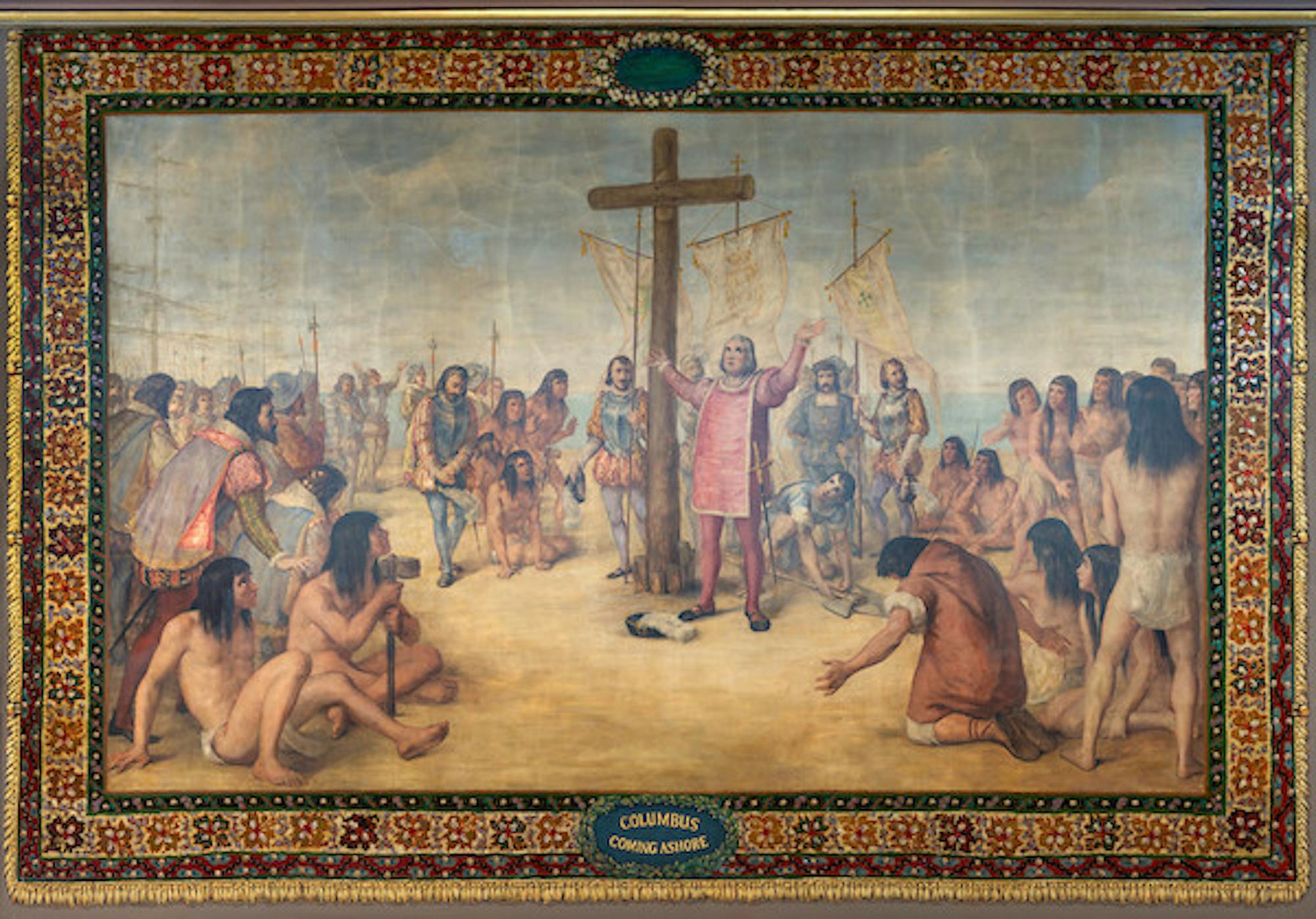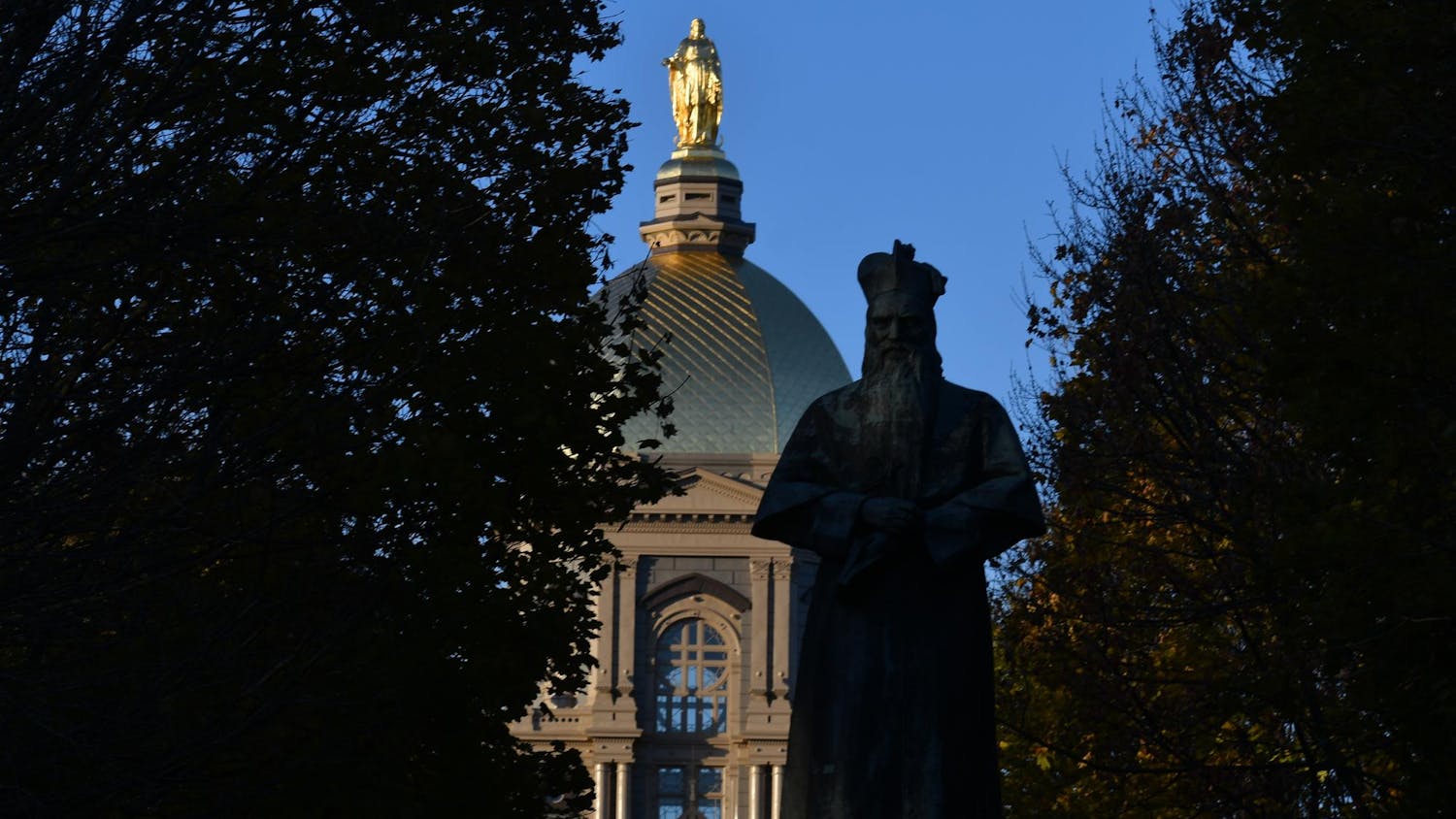This past week from Jan. 30 to Feb. 3, the Columbus murals on the second floor of the University’s Main Building were uncovered for instructional purposes. The 12 paintings depict Columbus’ arrival in the “New World,” his interactions with Indigenous people in the Caribbean and images of Spanish royals like Queen Isabella. They were covered with tapestries in 2020 post an announcement by Fr. Jenkins in Jan. 2019.
The first calls for the removal of the murals occurred in the 1970s, when the first few Indigenous students enrolled at Notre Dame and spoke about the mural’s racist and stereotypical depiction of Indigenous people. The protests were ignited again in the 1990s near the 500th anniversary of Columbus’ arrival in North America. Most recently, 300 Notre Dame students and faculty signed a petition in 2017 requesting the murals to be covered.
The Columbus murals were painted by Italian artist Luigi Gregori between 1881 and 1884. Notre Dame’s founder, Rev. Edward Sorin, brought Vatican artist Gregori to campus in 1874 as director of the Art Department. During his tenure, Gregori also painted decorative works in the Church of the Sacred Heart, now the Basilica, like the Coronation of the Virgin and other works in the Main Building like the allegorical painting on the interior of the dome that depicts “a female personification of Religion surrounded by Philosophy, History, Science, Fame, Music, and Poetry,” according to an exhibition catalog written by Sophia Meyers, who graduated from the University with an M.A. in Art History in 2010.
Columbus’ founding of the New World is now thought of as an event that “destroyed the already established civilizations of [Indigenous people in] two continents,’” Meyers writes. The catalog also acknowledges, however, that during the late 19th century when the murals were painted, novels like Washington Irving’s “The Life and Voyages of Christopher Columbus” (1828) portrayed Columbus as a heroic figure who “symbolized divine destiny and maverick Independence,” Meyers said in the catalog.
Since Columbus was a Catholic from Spain, the Notre Dame community in the late 1800s viewed him as an important Catholic figure in Protestant-dominated U.S. history. Kathleen Sprows Cummings, professor of American Studies, who took two of her classes to visit the murals this week expands on this idea.
Sprows Cummings, who teaches the courses “Notre Dame in America” and “Catholics in America,” says that in the 1880s many Americans believed Catholics couldn’t be good Americans because they were recent immigrants, and they supported the Pope.
“[Columbus] was presented as a figure who was a devout Catholic and who helped civilize the continent … It tells us an awful lot about what Father Sorin and Catholics in general wanted to say about themselves in the 1880s,” Sprows Cummings said.
Sprows Cummings said that while the murals are inaccurate and culturally insensitive, they provide an opportunity to understand the past and move the conversation forward.
“They portray a narrative that seems benign … this encounter between Columbus and Indigenous peoples as a Catholic story of conversion,” she said. “It … gives no hints of the genocide and cultural appropriation. I definitely think they should be covered, but I think there should be opportunities to talk about what it means and how we can understand … the limitations of our past.”
Ashlee Bird, Moreau post doctoral fellow in the department of American Studies is a Native American game designer who studies the representation of Indigenous people. She is Western Abenaki and originally hails from the Champlain Valley of Vermont.
Bird says that the murals should not just be covered up, but taken down completely.
“With Columbus as a figure, there’s this holding on to this narrative of discovery and glory that are … almost entirely fictional at this point. We know Columbus never set foot here, [in North America]. We also know that he kidnapped and sold young Indigenous girls into sex slavery,” she said. There’s accounts of him having his soldiers feed babies to their dogs. He openly stated that the Indigenous people would make good slaves because they were friendly and accommodating.”
Bird said that uncovering the murals has the detrimental effect of perpetuating negative and stereotypical images of Indigenous people.
“These histories of representation that have been violent and historically inaccurate either trap Indigenous peoples in places of history and violence or tokenize them. For teaching purposes, there are plenty of images of those murals that professors could show their students, there really isn’t any point other than to glorify them by seeing them in person,” Bird said.
Bird related the Columbus murals to her work with Indigenous representation in contemporary video games.
“Some games actually implicitly teach players to behave violently towards Native American people in digital spaces, regardless of if the game is telling them that they’re the bad guy or not. I don’t think something like the murals is that dissimilar honestly. We shouldn’t keep perpetuating these images of Indigenous people as subjugated or you worshiping a man who committed heinous acts against them,” Bird said.
Ben Heller, associate professor of Spanish, has taught classes where students have read Columbus’ diary along with other works from the period. As part of these classes, he would take students to see the murals in person.
“I think … it’s different from seeing something on a screen or on a page,” he said. “You’re in a large hallway with high ceilings, and you see the size of these murals, and that’s part of the …impact of these negative images. Seeing them in that context … and knowing that the admissions office for many years was right across the hall from the Columbus murals, you get a sense of the way in which the murals were embedded in the identity of the University and how that identity was conveyed to prospective students.”
Heller talked about the need to contextualize and understand Columbus’ project by reading his writings and the writings of critics like Bartolome de las Casas, a priest who documented many massacres against Indigenous peoples of Latin America.
“The journal that he completed, based on his first voyage to the New World, is absolutely fascinating, because there he records his first interactions with … Indigenous people of Latin America, in the Bahamas and in the Caribbean more generally. He very casually says that he took a number of Caribbean peoples back to Spain so that they can learn Spanish. What we’re seeing there is kidnapping and forcible movement of peoples and the beginnings of the mistreatment of Indigenous peoples that quickly developed into a system of slavery in the early 1500s,” Heller said.
In past classes before the murals were covered, Heller would discuss with his students what should be done with these relics. Some students talked about removing the murals and transferring them to a museum space, a move that would be technologically challenging considering the murals have been painted directly on the wall. Others thought about installing plaques next to the murals to help contextualize the history. Those students suggested descriptions should be written in English, Spanish and some Native American languages. Some students also thought about commissioning new artwork for other parts of the Main Building, which would tell the other side of the story from Native American perspective, preferably, from Native American artists.
Bird said that the reigning narratives about Columbus as a Catholic explorer stand in the way of the work that needs to be done between the Catholic Church and Indigenous peoples, particularly at Notre Dame, an institution that is on the land of Indigenous peoples.
Sprows Cummings also talked about how the University can acknowledge the legacy of Indigenous people, specifically the Pokagon Band of the Potawatomi, and have a wider understanding of Catholic role models. The Potawatomi originally lived on the land on which the University is built and had been practicing Catholicism since around 1830, 12 years before Fr. Sorin arrived from France in 1842.
“This land on which we teach and learn has been occupied by native peoples for hundreds of years, and we don’t do such a great job acknowledging that,” Sprows Cummings said.
She talked about Georgetown University’s memory project that recorded how in 1838, the Maryland Jesuits and Georgetown University sold more than 272 enslaved people from four Jesuit-owned tobacco plantations in southern Maryland to plantation-owners in southern Louisiana.
“I think Notre Dame should take a real lead among Catholic universities in grappling with this issue … akin to what Georgetown did starting in 2016,” Sprows Cummings said.
University uncovers Columbus Murals in Main Building for instructional purposes
July 13, 2020; Columbus Murals: Columbus Coming Ashore (Photo by Matt Cashore/University of Notre Dame)








